
The Importance and Benefits of a Google Business Profile
Published: May 5th, 2022
Last Updated: January 25th, 2024
Google products come, and Google products go—such is the nature of the Googleverse.
You might remember Google Urchin (the forebear of Google Analytics), Google Insights for Search (now merged with Google Trends), or Google Reader (the original and best RSS feed aggregator). Dead and buried. If you’ve been working in local marketing for a while, you might remember the Google My Business app, Google My Maps, CallJoy, and Google Hotpot… may they all rest in peace.
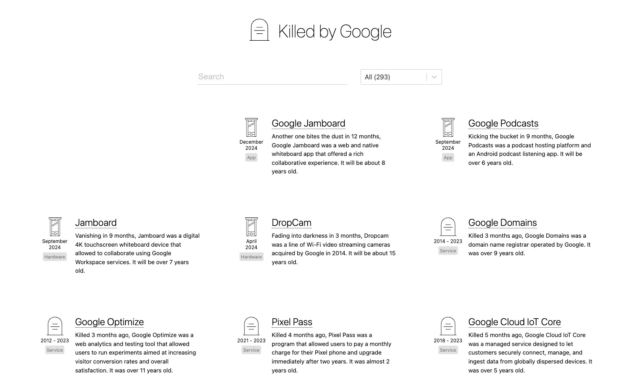
One product that has stood the test of time is what Google is currently calling Google Business Profile—or what I affectionately refer to as ‘the artist formerly known as Google My Business, Google Places, Google+ Local, and Google Local’.
Despite the assortment of names, the product has fundamentally remained the same. It’s a local business management product that allows business owners to manage (to some extent) the ways that their business shows up across Google products like Maps and Search.
Nine reasons a Google Business Profile is important for your business
This is not an exhaustive list because there are many benefits of owning and managing your GBP!
- Without a local business listing, you can’t rank in the Local Pack, or appear on Google Maps
- It’s often the first (or only) source of information that a potential customer will use
- Your potential customers can take actions that lead to a conversion right from the SERP
- It brings a variety of user-generated content into one place
- It gives you plenty of opportunities to signpost content on your website
- It’s a useful source for customer insight for your own business (and your competitors’ businesses)
- It’s used by potential customers to get directions to your business
- Its Insights section gives you important information about how people are finding you
- It influences Google’s understanding of your business as an ‘entity’
Without a local business listing, you can’t rank in the Local Pack or appear on Google Maps
Think of Google Business Profiles as existing in a Google database of businesses with a brick-and-mortar location or existing to serve customers in a specific geographic region.
This database is used to power results in the map pack in search, in the local finder, on Google Maps.
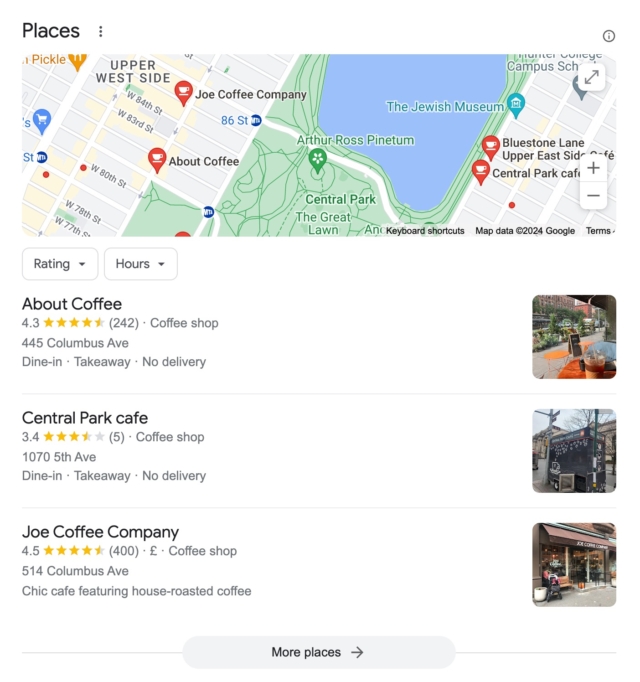
With the way that Google currently works, to appear in these results, a Google local business listing has to exist, as these listings are essentially what it uses to populate them.
You’ll also need to have a Google Business Profile if you want to get the full benefits associated with running Local Service Ads.
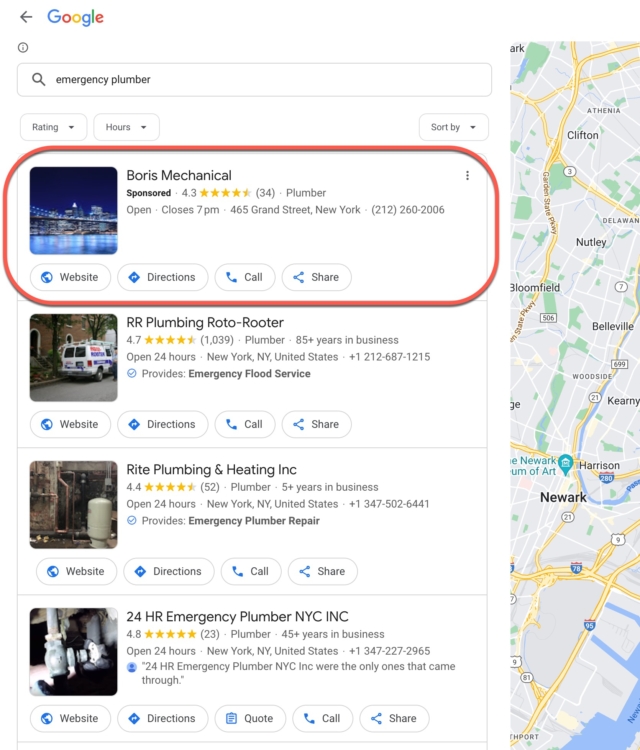
It’s often the first (or only) source of information that a potential customer will use
As SEOs, we are very familiar with the concept of zero-click search—the idea that, in many cases, the searcher’s intent is met within the search engine results page itself without the need to click away to a website. In fact, according to BrightLocal’s 2023 Local Business Discovery & Trust Report, the top three most trusted platforms for researching local businesses are Google (66%), Google Maps (45%), and then, finally, a business’s own website (36%)… meaning that the information on your GBP will be the first thing that most people look at when deciding where to custom. It also highlights that there is no guarantee they’ll click through to learn more.
As Local SEOs, we’ve been living in this zero-click world for some time. After all, it’s been years now that Google has been pushing more and more features and functionality into our Google Business Profiles as they display in the search engine results pages (SERPs).
- Want to look at photos of a business? Do this from the profile.
- Want to see if a business is open right now? Do this from the profile.
- Want to ask a question about the business? Do this from the profile.
- Want to message a business? Do this from the profile.
- Want to look at a menu or see how busy a location is right now? You guessed it—do these things from the profile.
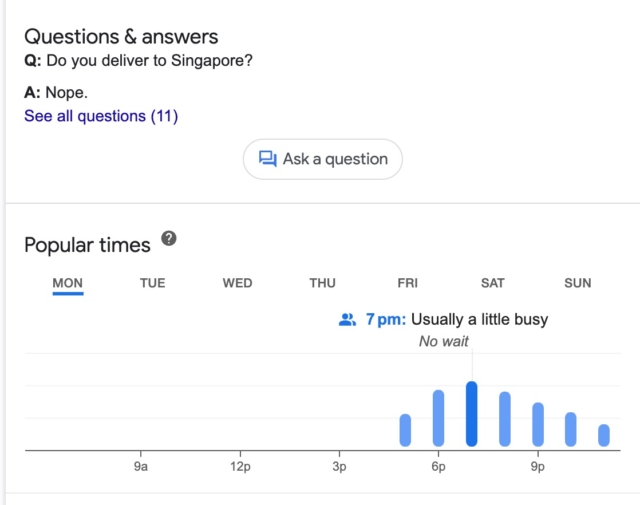
Because of all the things that a customer or potential customer can do via a profile, it’s a no-brainer that you need to have a listing that’s kept up to date.
Your potential customers can take actions that lead to a conversion right from the SERP
The previous point illustrates the amount of information that a potential customer can access via the business profile without clicking through to the website… the type of content that will help them in their early stages of decision-making when they’re trying to decide which business to choose.
We must also remember that customers who are a little bit further down their path in terms of being ready to make a conversion also have options in the SERP. Google Business Profile offers various functionalities and features that could be considered actual business conversions.
For example, the ‘order online’ link allows a customer to order ahead of time for collection or delivery:
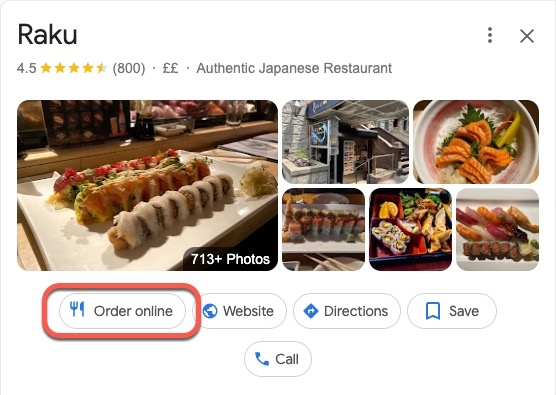
The ‘book online’ link allows you to schedule and book an appointment directly from the SERP.

It brings a variety of user-generated content (UGC) into one place
There was a time when ‘user-generated content’ was kind of a big deal—back in the day when we all became ‘creators’, and ‘web 2.0’ marked a shift in the general ease of creating content online.
Google Business Profile is an excellent example of where business-created content and user-generated content merge. Although a well-established and trustworthy business has the chance to manage its listing carefully in terms of the information that it chooses to share, it can never truly ‘control the message.’ As user-generated content merges seamlessly with business-generated content in most Google Business Profiles, the various messages become one… one that’s at least partially out of the hands of the business.
Examples of user-generated content in the business profile:
- Reviews
- Q&A
- Photos
- User updates—‘updates from customers’
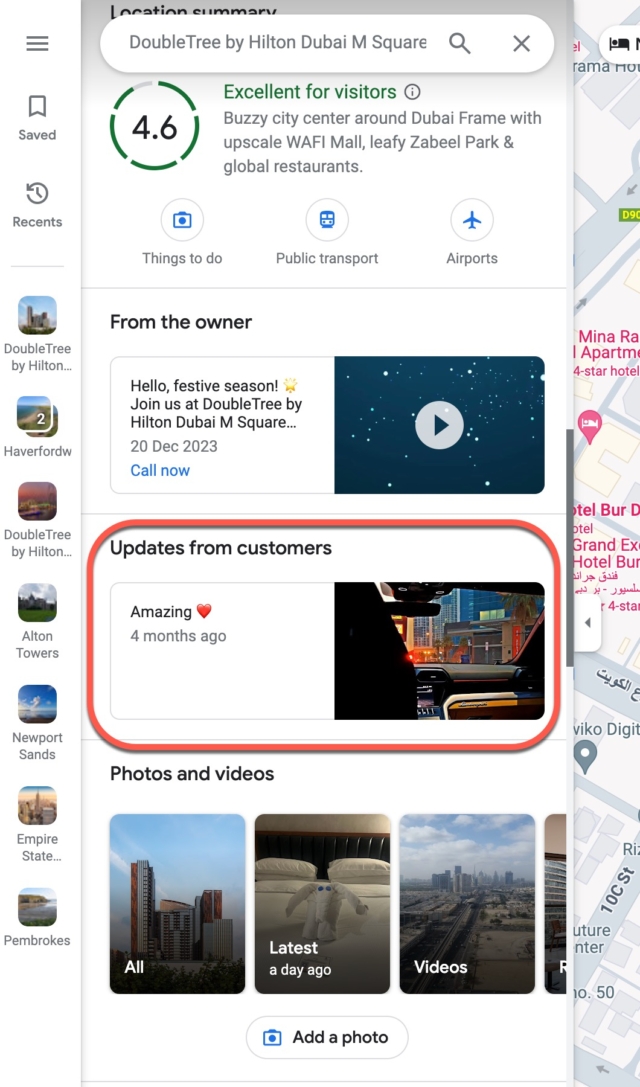
User-generated content can be great for businesses. It can also be… not so great:
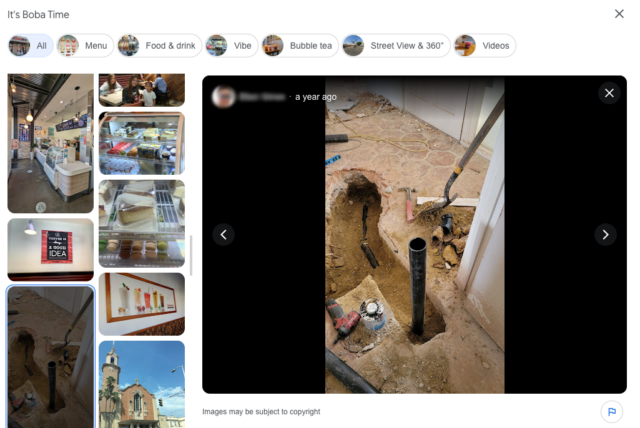
We all know that the various iterations of our ‘GBP content’ across Google’s assorted surfaces are the first (and sometimes only) content related to our business that our potential customers will consume.
So, now we know that GBP also combines our business-produced, carefully curated content with UGC (both good and not-so-great). With this in mind, we must be sure that we’re consistently monitoring, responding, and encouraging UGC (the good kind). We also need to be careful to try to suppress the UCG that breaches Google’s guidelines by reporting it accordingly.
It also reminds us that businesses need to be consistent with putting their best foot forward in all aspects, hoping that the UCG garnered in response paints them in a good light.
It gives you plenty of opportunities to signpost content on your website
The ‘website’ link in GBP will indeed drive the lion’s share of the traffic to your website—after all, it’s usually the most obvious link through to a website from any iteration of GBP across surfaces:
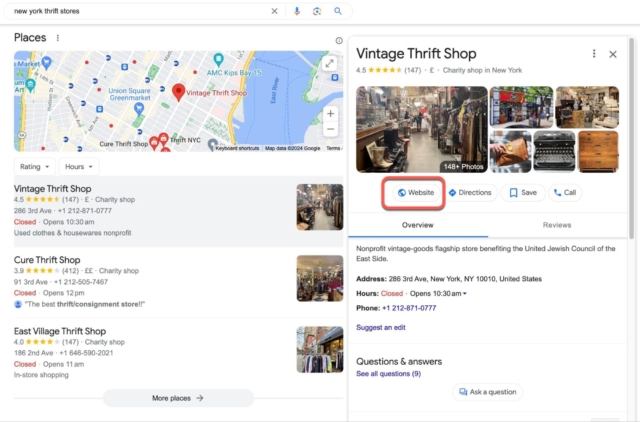
But it’s also a great opportunity to drive your potential customers to other spots on your site.
There are a bunch of other places where you can add a link to your website. This might sound obvious, but make sure that you’re linking to a page on your website that suits the intent of that feature and the potential customer that is likely to click.
Additional opportunities for linking (some are category-dependent):
- Google Posts
- Google Products
- Menu
- Appointment
Bonus points for adding UTM tagging to your GBP links so you can measure their impact in GA4.
It’s a useful source for customer insight for your own business (and your competitors’ businesses)
Sometimes we get so fixated on ‘managing’ or responding to UGC that we forget that monitoring and analyzing that content can give us terrific insight into how our customers and potential customers perceive or experience our products and services.
Reviews
Did you know that 98% of people read online reviews for local businesses, according to BrightLocal’s Local Consumer Review Survey? That’s a lot of eyes on the reviews you get and a lot of minds that could be swayed based on what they say.
But it’s not just about what potential customers see in your reviews; it’s about what you can see.
By analyzing the textual content of our reviews, we can surface themes and topics that can indicate our business’s strengths and weaknesses. If you’re a multi-location business, you can group that content in any number of ways (by geography, service offering type, size, etc) for insight.
Make sure to look at the review topics for your business(es)—that’s where Google offers up their take on the commonly occurring themes within your reviews:
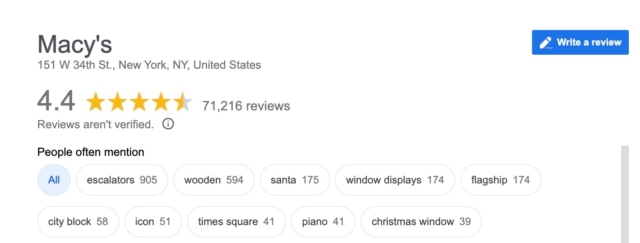
Are your reviews highlighting issues with your product or service delivery? Go ahead and fix them.
Are your reviews uncovering unseen strengths or facets of your product or service that are important to customers and that you were unaware of? Go ahead and highlight this feedback and those strengths in your marketing materials!
Q&A
Take a look at the questions that are asked in the questions & answers (Q&A) section. Although Q&A can be full of guff, there is also the occasional insight: are there questions here that you should be answering on your website, in your other content, or across various channels?
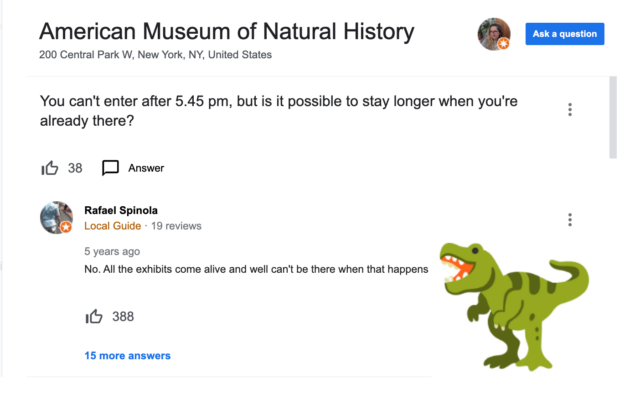
It’s used by potential customers to get directions to your business
This might seem like an obvious one, but Google Maps is the mapping application that is going to inform your potential customers as to where you are located. Furthermore, it’s likely the app that will guide them on their journey to you.
That might be using the app on their phone, via the navigation system in their car, or via a third-party app that uses Google mapping technology at its core (such as Lyft). No matter how the customers find those directions, they must lead to the right place!
Its Insights section gives you important information about how people are finding you
We’re used to Google obfuscating our search query data (anyone remember the good old days when keyword data flowed freely into GA?), so we shouldn’t look a gift horse in the mouth.
When you have a Google Business Profile, Google offers up a range of data points—one of which is related to the search terms that searchers use when they trigger a Google SERP that shows your business profile:
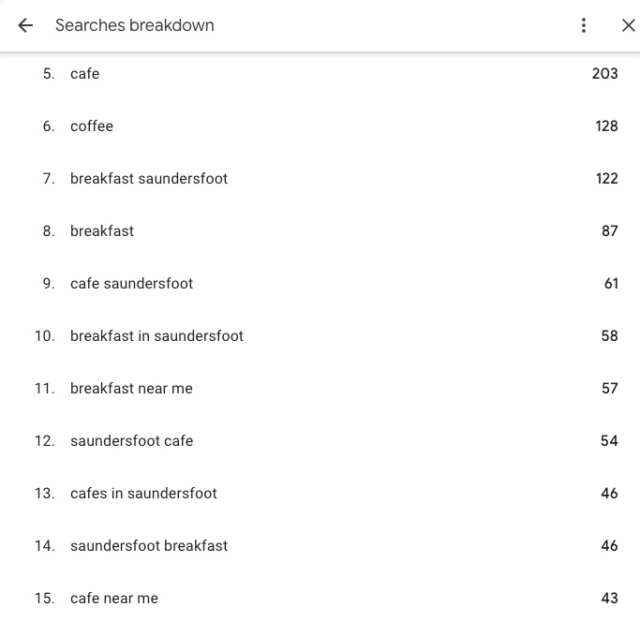
It influences Google’s understanding of your business as an ‘entity’
This might sound a bit fluffy, but on a very basic level, your Google Business Profile is one way for you to use a Google Product to feed into Google’s Knowledge Graphs directly.
If you’re unfamiliar with the concept of ‘things, not strings’, read this.
By making sure that all of your details are correct in GBP—including your name, address, phone number, and details of your products and services—and making clear to Google the connection between your GBP, your websites, and your social media channels, you’ll be making a good start in terms of ensuring that Google has a clear idea of who you are, what your business is, and who you serve.
Time to Get Started
It should be clear by now that GBP offers a wide range of benefits to businesses and search users alike. In addition to being the top local SEO ranking factor for the Local Pack, it also makes it easy to showcase useful information about your business, ultimately making the process of searching for, comparing, and selecting a relevant local business much easier for local consumers.
With bottom-line boosting benefits such as booking and reservation buttons plus the ability to share offers, news, and imagery, it can also make a notable difference to your local business. Getting your GBP up and optimized can have a vital impact on the success of your business, so be sure to stay on top of it.
